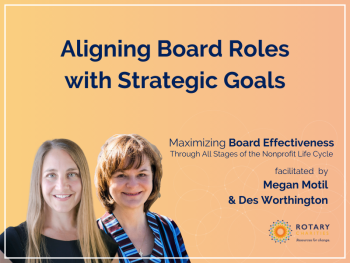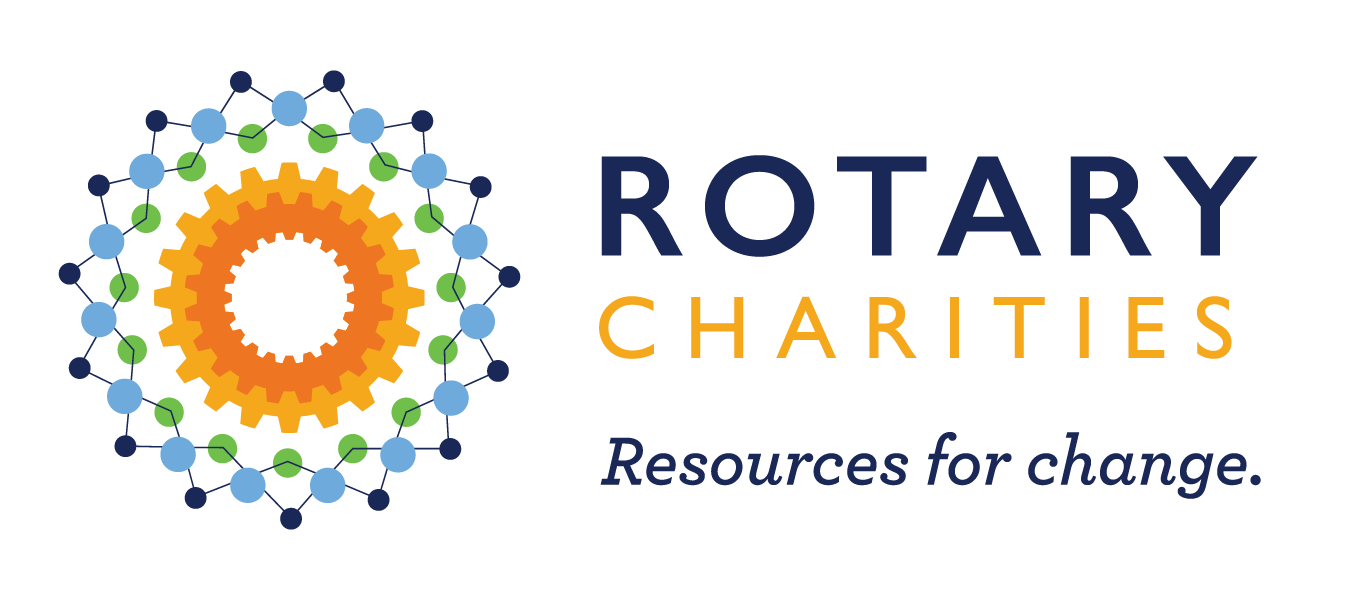Aligning Board Roles with Strategic Goals

Understanding the Importance of Strategy in Nonprofit Organizations
Strategic planning is crucial for the success of nonprofit organizations, serving as a roadmap that guides the implementation of their mission and charts a course for long-term impacts.
This blog introduces key concepts from the third session of our five-part series on Maximizing Board Effectiveness, held on May 2, 2024, focusing on Aligning Board Roles with Strategic Goals. The workshop explored the importance of strategic planning, common barriers faced by nonprofit boards, and the roles and mindsets essential for effective strategy development and execution at various organizational life stages.
Megan Motil and Des Worthington, experts in nonprofit governance and fundraising, emphasize the transformative power of a well-crafted strategy. "Reality is your friend," Megan advises, underscoring the importance of being realistic when assessing your organization’s capacity to execute your strategy. She adds, "The promise you're making with the story of your strategy is not just a promise to yourself; you're making a promise to the community."
Your strategic plan aligns the organization’s vision with actionable goals, creating a clear path forward. It helps organizations identify core problems, allocate resources efficiently, and measure progress effectively. Without a strategy, nonprofits risk confusion, inefficiency, and ultimately, mission drift.
Common Barriers and Obstacles in Nonprofit Board’s Strategy Efforts
Despite the clear benefits, many nonprofit boards face significant obstacles in their strategic planning efforts.
Some of the common barrier and obstacles that nonprofits encounter include:
Lack of Strategic Planning History:
Some nonprofit organizations, especially those in the start up or growth lifecycle stages, may not have a tradition or history of strategic planning. Without established processes and a culture that values strategic planning, it can be difficult to initiate and sustain strategic efforts.
Undefined Board Roles:
When the roles and responsibilities of board members in the strategic planning process are not clearly defined, it can lead to confusion and inefficiency. Board members may be unsure of their specific duties, which can hinder effective strategy development and execution.
Negative Past Experiences:
Previous bad experiences with strategic planning can create a negative mindset towards future planning efforts. If past strategies were poorly implemented or did not yield the expected results, board members may be reluctant to engage in new strategic planning initiatives.
Strategy as a Vision Without Action:
Sometimes, organizations mistake having a vision or idea for having a strategy. However, a true strategy involves actionable plans and measurable goals. Without tying the vision to operational plans and resources, organizations may struggle to move from ideation to execution.
Resistance to Change:
Organizational inertia and resistance to change can impede strategic planning efforts. Board members and staff may be comfortable with the status quo and reluctant to embrace new strategic directions.
Power Dynamics and Inequity:
Without a strategic plan, underlying power dynamics and inequities within the organization may drive decision-making. This can lead to decisions that are not in the best interest of the organization and its mission.
Additionally, confusion about the board's role in strategy and a focus on tactical metrics rather than strategic direction can hinder progress. Overcoming these barriers requires a cultural shift within the organization, fostering an environment where strategic planning is valued and understood. This involves clear communication, role definition, and a willingness to learn from past experiences and adapt to new challenges.
What Happens Without a Strategy
"While strategic planning might not be the most exciting task, having a solid plan ensures everyone is in agreement,” warns Des. “When disagreements occur, you can point back to the plan and say, ‘We agreed to this.’ Without it, infighting and misalignment can create chaos within the organization.”
The absence of a strategic plan can have far-reaching negative consequences for a nonprofit organization. Without a clear strategy, organizations often find themselves adrift, lacking direction and coherence in their actions. This state of disarray can manifest in several ways:
Difficulty in Partnering and Collaboration:
Nonprofits without a strategy struggle to form effective partnerships. Collaboration requires a mutual understanding of goals, capacities, and resources. Without a strategic plan, it's challenging to communicate these aspects to potential partners, leading to missed opportunities for synergy and impact.
Resource Competition and Allocation Issues:
In the absence of strategic direction, nonprofits may face unresolved competition for resources. This can result in inefficient allocation of funds, staff, and time, as there is no clear prioritization of initiatives that align with the organization's long-term goals.
Persistent Obstacles and Unrealistic Expectations:
Organizations without a strategy often find themselves encountering the same obstacles repeatedly, unable to overcome them due to a lack of focused efforts. Additionally, without a plan, expectations may become unrealistic, with stakeholders unsure of what can be feasibly achieved, leading to disappointment and frustration.
Lack of Accountability and Chasing Grants:
Without a strategic framework, roles and responsibilities within the organization are often unclear, leading to a lack of accountability. This can also result in the organization chasing grants that do not align with its core mission, simply because there is no strategic guidepost to follow.
Stagnation and Burnout:
Teams without strategic direction often become "stuck" in ideation, unable to move from planning to execution. This stagnation not only hampers progress but also contributes to staff and board member burnout, as they feel overwhelmed by the lack of progress and clear direction.
Difficulty in Inspiring and Retaining Stakeholders:
A lack of strategy makes it hard to inspire confidence among donors, recruit board members, and retain staff. Without a clear vision and plan, it becomes challenging to communicate the organization's mission and impact compellingly, leading to decreased support and engagement.
Inequitable Decision-Making and Power Dynamics:
In the absence of a strategic plan, decision-making is often driven by underlying power dynamics rather than a shared vision. This can result in inequitable decisions that do not reflect the organization's values or serve its mission effectively.
Confusion and Poor Communication:
Without a strategy, there is often confusion about priorities and goals within the organization. This leads to poor communication, both internally among staff and board members, and externally with stakeholders and the community.
The Board’s Role in Strategy at Different Organizational Life Stages
The role of the board in strategic planning varies significantly depending on the organization's life stage. From the founding phase to growth, maturity, and potential decline, the board's responsibilities and focus areas shift to meet the evolving needs of the organization. Understanding these nuances is crucial for effective governance and strategic development.
Startup Phase:
In the startup phase, the board is deeply involved in shaping the organization's vision, mission, and foundational strategies. This stage is characterized by high levels of engagement as the board works to establish the initial direction and structure of the nonprofit. Boards evaluate community needs, set foundational goals, and make critical early decisions that will influence the future trajectory of the organization.
Megan Motil highlights the importance of this stage: "If you're a startup, you’re probably responding to a need in the community and asking yourself, what's the best thing we can do right now to make a difference?"
Growth Phase:
As the organization transitions into the growth phase, the board's focus shifts to scaling impact and building internal capacity. This involves developing systems and processes to support expanding operations and ensuring that the organization can sustain its growth. The board must navigate leadership changes, such as hiring the first executive director or adding key staff members, and focus on creating stable systems for relationship building and fundraising.
Megan explains, "In a growth phase, you might be asking yourself questions like ‘How do we scale? How do we grow in our impact? What kinds of systems or processes do we need to put in place so that we can become a little more stable in the way we're functioning?’"
Maturity Phase:
In the maturity phase, the board guides the organization in assessing its strategic position within the broader landscape of nonprofits and community entities. This stage involves refining operations, optimizing revenue models, and potentially shifting focus areas to meet evolving community needs. The board evaluates the effectiveness of current strategies and explores new partnerships or initiatives to maintain relevance and impact.
Megan notes, "As you move into maturity, you might be asking yourself questions again about scale. You might be shifting your focus because you realized what you're doing isn't having the impact it once had."
Decline Phase:
During the decline phase, the board faces the challenging task of deciding the organization’s future direction. This could involve pursuing renewal and restructuring efforts or winding down operations. The board must critically assess whether to merge with another organization, reimagine its mission, or cease operations altogether.
Megan elaborates, "If you're in the decline phase, you might be asking questions like, ‘what direction are we taking? Are we going to unwind? If so, how do we do that in a way that feels respectful and honors the past, honors relationships and moves forward?’"
Key Considerations Across Life Stages
Regardless of the organizational life stage, there are several key considerations for boards to keep in mind:
Alignment and Clarity:
Ensuring that all board members are aligned with the organization’s strategic goals and clear on their roles is crucial. "Role clarity sets the foundation for effective governance and ensures that everyone is aligned and accountable," Megan emphasizes.
Realistic Planning:
Boards must be realistic about the organization’s capacity and resources. Setting achievable goals based on accurate assessments of capabilities helps prevent frustration and failure.
Continuous Evaluation:
Regularly evaluating progress and adapting strategies as needed is essential. Using tools like dashboards and progress reports helps track success and identify areas needing adjustment.
Engagement and Communication:
Effective communication and engagement with all stakeholders, including staff, donors, and community members, ensures that everyone is on the same page and working towards common goals.
Putting Your Plan to Work
Effective strategic planning is not just about creating a document that sits on a shelf. It involves continuous evaluation, realistic goal-setting, and clear communication. By recognizing the unique needs and challenges of each life stage, nonprofit boards can provide the necessary oversight and strategic direction that fosters growth, stability, and sustainability.
In addition to discussing the board's evolving role across different life stages, Megan introduced valuable resources to help boards effectively integrate strategic planning into their routines. She highlighted a sample board meeting planning calendar, designed to ensure that strategic discussions are regularly scheduled and prioritized throughout the year. Alongside this, Megan shared a strategic planning cadence matrix, a tool that helps organizations establish a rhythm for strategic planning activities, aligning them with regular board and committee meetings. These resources provide practical frameworks to maintain a consistent focus on strategic goals, ensuring that the board remains proactive and aligned with the organization's mission at every stage.
Elevating Board Fundraising Engagement
In the next session, we explored strategies for elevating board fundraising engagement. Fundraising is a critical component of nonprofit sustainability, and board members play a pivotal role in these efforts. We discussed practical approaches for engaging board members in fundraising activities, setting clear expectations, and building a culture of philanthropy within the board.
Downloadable Resources:
Sample Board Meeting Planning Calendar
Strategic Planning Cadence Matrix
Sample Board Meeting Agenda featuring Board Governance and Strategy Focus and Roles


